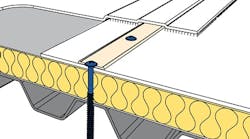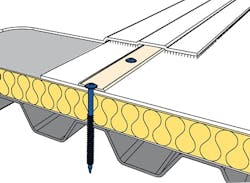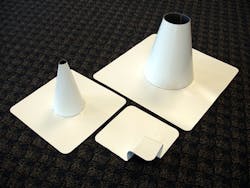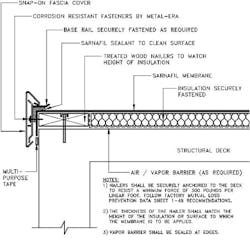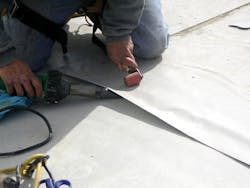Recent Roofing News e-newsletters have followed the U.S. Corps of Engineers’ Commentary on Roofing Systems, including sections on bituminous, modified bituminous (MB), and EPDM roofing systems. This column will cover weldable single-ply systems, including thermoplastic polyolefin (TPO), polyvinyl chloride (PVC), ketone ethylene ester (KEE), chlorinated polyethylene (CPE), chlorosulfonated polyethylene (Hypalon® or CSPE), and polyisobutylene (PIB).
Weldability
All of these thermoplastic materials can be fused together by the application of heat, although self-adhesive and solvent-welded sheets have been used as well. As compared to the EPDM materials mentioned last month, these sheets do not form permanent cross-links (through vulcanization). In the absence of cross-links, thermoplastic roof membranes are subject to creep or cold-flow under stress. Most products rely upon internal reinforcement such as woven scrim while others use a non-woven fleece backing material.
Standards and Specifications for Thermoplastic Membranes
Since the issuance of the Corps’ technical instruction in 1999, a number of new and upgraded ASTM specifications have appeared:
- D4434 for PVC materials.
- D5019 for CSPE.
- D6754 for KEE.
- D6878 for TPO.
- D7067 for white reinforced PIB.
ASTM has also published a number of recommended practices for these systems:
- D5036 application of fully adhered PVC.
- D5082 application of intermittently attached (mechanically fastened) PVC systems.
In addition to the ASTM specifications, a number of important documents have recently been issued:
- A Guide for the Wind Design of Mechanically Attached Flexible Membrane Roofs (IRC-47652E), National Research Council Canada’s Institute for Research in Construction.
- FM Global Property Loss Prevention Data Sheet 1-29, Roof Deck Securement and Above-Deck Roof Components (updated August 2007).
Advantages of Thermoplastic Roof Systems
With the exception of PIB, all these materials can be heat-welded in the field. These are true welds, with strength equal to or greater than the sheets themselves. As a result, seam failures are rare. With the advent of automatic heat welders, seam formation is not especially labor intensive, although skilled operators are required. For many mechanically fastened systems, double welds are now recommended, as the wind up-lift resistance of these systems is significantly better than the single welds of previous generations. (See Fig. 1 for an example of a double-weld cutaway.)
Figure 1.
Light-colored sheets are used both for aesthetics and to optimize longevity. The internal reinforcement helps reduce thermal contraction or shrinkage of the sheets, as well as to improve tear resistance. While ballasted systems have been used in the past, they are rarely used today since the fully adhered and mechanically fastened systems are much lighter in weight. Ballast was first eliminated from PVC systems when it was discovered that the ballasted roofs were becoming brittle much quicker than with exposed membranes. This was attributed to extraction of plasticizer through hydrolysis (much like kitty litter absorbs liquids).
Field Conditions
For fully adhered systems, the nature and condition of the substrate is very important. If solvent-based field adhesives are to be used, the thermal insulation boards must be resistant to solvent fumes. This generally eliminates all polystyrene boards unless a suitable cover board is used. In addition, boards with low peel strength (such as perlite) should also be avoided.
For mechanically fastened systems, fasteners are typically placed within the seam area, using stress plates to distribute forces. Although it is technically possible to use rigid anchor bars in the overlap, it is not recommended to use the bars in the seam area, unless a double weld is to be used. For extreme wind conditions, bars and cover battens can be used in the field of the sheets. FM data sheet 1-29 illustrates some of these options.
If roofing rolls have been stored under cold conditions, they should be unrolled and allowed to reach ambient temperatures. Instructions suggest allowing the sheets time to “relax,” as otherwise they may contract due to built-in stresses (memory). TPO sheets have been reported to prematurely crack when the applicator has bent the sheet back 180 degrees while installing fasteners or wiping the seam area.
MSDS labels should be read and understood, and many of these systems use flammable solvents. Fumes may be objectionable to occupants. This could require shutting down air-intake equipment or constructing temporary elevated intake ducts to avoid problems. Solvents may extract oils from the workers’ skin; gloves may be required.
Energy Considerations
Most of the single-ply systems incorporate energy-efficient, lightweight thermal insulations such a polystyrene or polyisocyanurate. Attention is needed in mechanically fastened systems to incorporating air retarders, as air leakage can be an important source of wasted energy. In the absence of an effective air retarder, mechanically fastened systems billow and allow lateral airflow. Some states (Massachusetts, Minnesota, etc.) actually mandate the use of an air retarder in their energy and/or building codes.
Some of these membrane systems are conducive to photovoltaic cells being bonded directly to the surface.
Since most of these membranes are light-colored and non-metallic, they generally meet ENERGY STAR® and governmental requirements for air-conditioned buildings. Dirt accumulation may be a factor, especially on poor-draining roofs. While washing the roofs may be possible, it may not provide a positive payback over time.
Aesthetics
Some concern has been expressed that white membranes may be objectionable due to excess glare and may be slippery when ice films are present. (Black membranes look darker when wet while white membranes show no difference in appearance.) Extruded plastic battens have been introduced that, from a distance, look very much like a raised-seam metal roof.
Design Considerations and Alerts
As with EPDM systems, pipe boots and witches hats are available (see Fig. 2), as well as preformed inside and outside corners.
An additional feature: Polymer-coated metal may be used to form vertical flashings since the thermoplastic membranes can be heat-welded to the polymer coating.
The extreme flexibility of these membranes permits the avoidance of cant strips. For edge metal, many factory-formed snap-on metal fascia systems are available. The membrane is either bent down the outside wood nailer or carried up a raised flange to be covered by the fascia system (see Fig. 3).
Figure 3.
As with fleece-backed EPDM, the fleece serves as a separator when the substrate consists of an old bituminous roof-containing soft bitumen (e.g. as coal-tar pitch, Type I asphalt, asphalt mastic, or a resaturant).
Experience with Thermoplastic Membranes
In Europe, thermoplastic membranes (mainly PVC) dominate the low-slope market. Many first-generation PVC systems had failures due to a poor choice of plasticizer or inadequate specifications, particularly in ballasted applications. These products have been eliminated through the test of time, and the few remaining PVC and KEE products have proven their durability in excess of 20 years. Other systems such as CPE and CSPE were found to be more difficult to weld and repair than PVC and TPO, and represent a diminishing niche in the single-ply market. TPO represents a growing share of the market, but not all TPO products are the same (many of which are not adequately defined by ASTM standards, especially when it comes to welding techniques). Designers and specifiers should not accept “equals” for a selected system until this part of the market stabilizes.
Maintenance Considerations
Coatings are generally not required nor recommended for thermoplastic membranes. If algae are darkening the sheets, treatment with detergent and diluted bleach solutions may help.
If patches are attempted, the bottom (unexposed side) of the membrane will be more receptive to welding. For cuts or tie-ins of new equipment, a patch can be inserted under the existing membrane and a few inches wider than the hole. A handheld heat welder and roller are used to make the repair (see Fig. 4).
Figure 4.
Substrates and Underlayments
For adhered membrane systems, the underlayment must be membrane-supplier approved, as low shear or dusty products could cause bonding problems. In addition, some IsoBoard facers have delaminated in service, so membrane suppliers generally require the use of approved IsoBoard insulations. In most cases, the facer or top surface of the insulation should be asphalt-free.
In regions that experience hailstorms with large hail (greater than 1.5 inches in diameter), higher-density substrates have proven effective, as has the use of thicker membranes (e.g. 90 mil instead of 45 mil material).
For roofs exposed to considerable roof traffic, walkways consisting of recycled membrane have been used. While some manufacturers recommend fully adhering the pads, others recommend factory-bonded welding tabs so that water can escape from beneath the pads.
Flashings and Penetrations
Vertical flashings for most thermoplastic systems do not require a cant strip since the membrane sheets are very flexible; however, edge restraint and termination bars are used to keep the flashing and membrane in place. Many systems use polymer-coated metal for vertical flashings. Rather than lap the metal flashing sheets, a gap is left, which is covered with welded membrane. This serves as a mini-expansion joint permitting metal movement.
Circular pipe penetrations are weatherproofed by the use of witches hats (flexible boots) that are welded to the horizontal roof membrane and clamped to the pipe. For multiple or angular penetrations in a small area, pitch-pockets can be used. Instead of the bituminous filler customarily used for BUR and MB systems, curing elastomeric compounds are used (either catalyzed or moisture-curing).
Resources
- ASTM Intl. (formerly known as the American Society for Testing and Materials)
- National Research Council of Canada’s Institute for Research in Construction
- National Roofing Contractors Association
- Single Ply Roofing Industry
- Unified Facilities Criteria: Commentary on Roofing Systems
